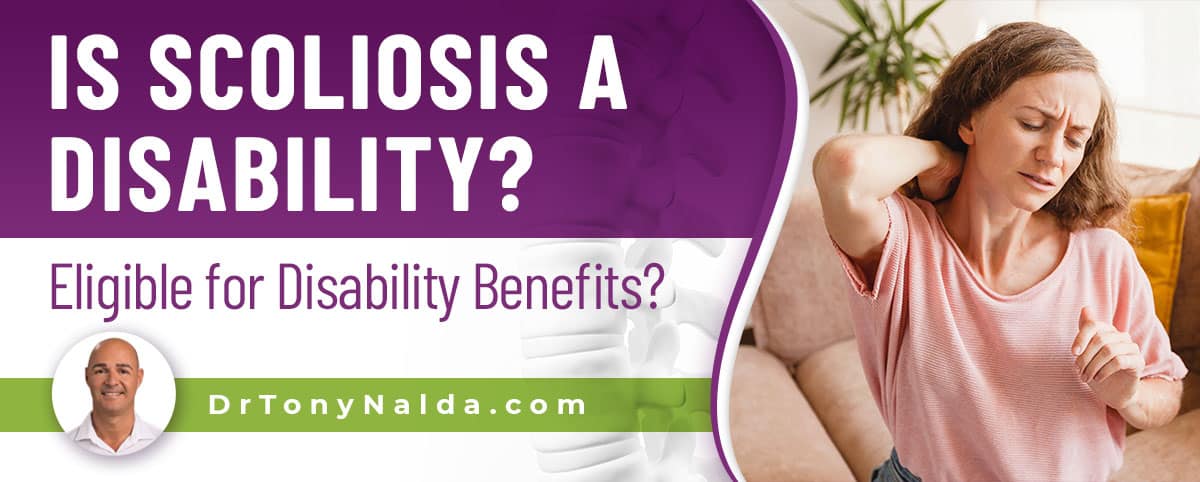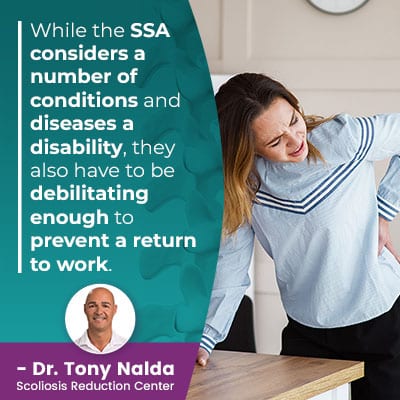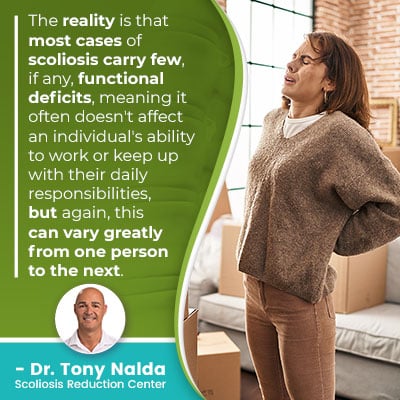Is Scoliosis A Disability? Eligible for Disability Benefits?

For people recently diagnosed with scoliosis, questions involving work and quality of life are common. While scoliosis is a progressive condition with no known cure, it is highly treatable and develops across a wide severity spectrum: mild, moderate, severe, and very severe. Whether a person qualifies for disability benefits for scoliosis will depend on a number of factors that vary from person to person.
The United States Social Services Administration (SSA) has a strict list of criteria that has to be met in order to collect disability payments. Whether a person meets the guidelines or not will depend on condition severity, related complications, and the type of work involved.
Before getting to the specifics of SSA rules and regulations, let's first discuss what it means to have scoliosis.
Table of Contents
What is Scoliosis?
Being diagnosed with scoliosis means an unnatural sideways spinal curvature has developed, with rotation, meaning the spine doesn't just bend unnaturally, but also twists, making it a 3-dimensional condition.
In addition, the diagnostic cutting point for scoliosis dictates that a scoliotic curve has to be of a minimum size (Cobb angle of 10 degrees) to be considered a true scoliosis.
Cobb angle is a measurement taken during X-ray that tells me how far out of alignment a scoliotic spine is, and classifies conditions based on severity (an important factor in disability benefit eligibility):
- Mild scoliosis: Cobb angle measurement of between 10 and 25 degrees
- Moderate scoliosis: Cobb angle measurement of between 25 and 40 degrees
- Severe scoliosis: Cobb angle measurement of 40+ degrees
- Very-severe scoliosis: Cobb angle measurement of 80+ degrees
Clearly, with such a variance in severity, symptoms one patient experiences aren't necessarily indicative of what others will face, and in addition, there are also different types of scoliosis a person can develop.
The most prevalent condition type is idiopathic, meaning no known cause, and this accounts for approximately 80 percent of known diagnosed cases, while the remaining 20 percent is associated with known causes: neuromuscular scoliosis, congenital scoliosis, degenerative scoliosis, and traumatic scoliosis.
Different condition types have their own unique characteristics and treatment needs, so this is another important factor when it comes to determining eligibility for disability benefits for scoliosis.
Another important condition feature to understand is that as a progressive condition, it has it in its nature to worsen over time, particularly if left untreated, or not treated proactively.
So where a scoliosis is at the time of diagnosis is not indicative of where it will stay, so when disability benefits are applied for is also important.
Now that we've defined the condition, the parameters that have to be met to reach a diagnosis of scoliosis, and discussed some key condition variables, let's address how it's determined whether a person's scoliosis is considered a disability or not.
Are People with Scoliosis Eligible for Social Security Disability (SSD) Benefits?
The Supplemental Security Income and Social Security Disability programs were established to help people with disabilities; they can provide income, or supplement income, to assist people who are unable to work due to having a disability.
To be deemed eligible to receive disability benefits, however, is not a simple process, and a person will have to prove two main things: that their condition makes them unable to work, and that their condition satisfies the SSA's definition of disability.
The Social Security Disability Insurance (SSDI) program pays out benefits to people who have worked for long enough current periods of time, and have paid into Social Security taxes from their earnings.
If a person meets both the medical and non-medical criteria and are considered unable to find alternative sources of work and income, they can be deemed eligible for monthly disability benefits.
One of the requirements that needs to be met is a person's scoliosis would have to be shown to have lasted, or will continue to last, for at least the duration of an entire year, or result in death.
As scoliosis is progressive and incurable, the first stipulation of the condition lasting will be the easier one to meet, but as scoliosis is highly unlikely to cause a person's death, the last stipulation is unlikely to be met.
Let's now address the specifics of whether or not scoliosis is considered a disability.
Is Scoliosis a Disability?
 While the SSA considers a number of conditions and diseases a disability, they also have to be debilitating enough to prevent a return to work.
While the SSA considers a number of conditions and diseases a disability, they also have to be debilitating enough to prevent a return to work.
The SSA has created a comprehensive list of diseases and conditions that is broken down into sections and categories; scoliosis falls under the umbrella of Musculoskeletal Disorders.
For scoliosis to meet the parameters of a disability set forth by Social Services, it has to meet the following criteria:
- The scoliosis has to prevent the individual from doing the work they did prior to being diagnosed
- The scoliosis also has to prevent the individual from doing similar work
- The scoliosis has lasted at least a year, is expected to last a year, and/or can result in death
While there is no specific section set aside for scoliosis in the SSA's comprehensive list of disabilities, it falls under Section 1.00 Musculoskeletal System, which then further funnels scoliosis into Section 1.04: Disorders of the Spine.
Even though scoliosis doesn't have its own section and listing, if a condition is severe enough to cause functional deficits, it's classified amongst listed spinal disorders.
Scoliosis is complex because, particularly if left untreated, it can lead to complications such as lung impairment and cardiovascular issues, which can mean an individual with scoliosis might also qualify for disability status under listings of respiratory disorders and/or cardiovascular disorders.
To prove the seriousness of scoliosis as a disability, specific medical evidence that documents the condition from its initial diagnosis to the application for disability benefits is needed; this commonly includes medical records, insurance records, physical examinations, X-ray images, and another other important information proving the debilitating nature of an individual's scoliosis.
Working with Scoliosis
As mentioned earlier, there are many different types and severity levels of scoliosis, and in the majority of mild and moderate cases, working with scoliosis is rarely affected; in fact, one of the biggest challenges to treating the condition's most-prevalent type, adolescent idiopathic scoliosis, is early detection.
While it can seem hard to imagine that an adolescent could be living with an unnatural sideways spinal curve unnoticed, it's very common.
With the exception of severe cases, scoliosis symptoms can be subtle and don't generally include pain in patients who are still growing, which is why it's so common for young patients to go through their adolescence with neither a diagnosis nor treatment.
It's not until the condition becomes compressive in adulthood that it tends to start causing noticeable symptoms and pain.
 The reality is that most cases of scoliosis carry few, if any, functional deficits, meaning it often doesn't affect an individual's ability to work or keep up with their daily responsibilities, but again, this can vary greatly from one person to the next.
The reality is that most cases of scoliosis carry few, if any, functional deficits, meaning it often doesn't affect an individual's ability to work or keep up with their daily responsibilities, but again, this can vary greatly from one person to the next.
Particularly in adult scoliosis, complications are more common in the form of mobility issues and/or pain, and this is why idiopathic scoliosis is commonly diagnosed in adulthood.
When it comes to obtaining disability benefits, it's not just condition characteristics such as severity and type that determine how a person's life, and ability to work, will be affected, but also an individual's overall health and wellness prior to being diagnosed with scoliosis; a person who is fit and healthy prior to developing scoliosis is more likely to experience minimal effects than an individual who is in poor health at the time of their diagnosis.
Individuals who maintain a healthy diet, weight, and activity level are likely to have an internal environment that's more conducive to healing and is going to be more responsive to scoliosis treatment.
When it comes to working with scoliosis, the type of job is, obviously, an important factor; the more physical a job is, the more likely it is that related mobility issues can impact an individual's ability to continue that type of work.
Proving an Inability to Work to the Social Security Administration
As mentioned, proving an inability to work to the SSA will require medical records, workplace documentation that provides a comprehensive list of daily responsibilities, and how scoliosis has impacted the individual's ability to perform them.
In addition, information documenting prior work done will also be needed, as well as information explaining why an individual's scoliosis prevents them from doing past work.
Social Security administration will assess any and all limitations an individual is experiencing due to their scoliosis, including physical, mental, and/or sensory.
A residual functional capacity (RFC) form will be used to determine if there is a similar type of work that can be performed, as well as assessing whether an individual's condition, age, health, experience, and education will affect their ability to return to current work, or find an alternative source of work and income.
Based on the aforementioned findings and the medical records provided, Social Services administration will determine whether or not an applicant is able to work, and if they are eligible for monthly benefits, the amount they are entitled to, and the validity of an individual's disability claim.
Keep in mind that this article was written according to Social Security Disability benefits requirements in the United States, so people in other countries will have to adhere to their own country's guidelines and requirements.
In addition, the rules and regulations regarding how long a person has to work, or amounts that have to have been paid into Social Security can fluctuate, so make sure information is current, up to date, and relevant to an individual's specific situation.
Conclusion
So is scoliosis a disability, and are people with scoliosis eligible for disability benefits? The answer is as complex as the condition itself and will be case-specific.
Whether or not an individual's scoliosis is considered a disability by the Social Services Administration will depend on a number of important patient/condition variables.
Because there is such a wide range of severity and different condition types, each case is unique; for residents of the United States, certain criteria will have to be met regarding the nature of their scoliosis, how long they've worked, what they've paid into Social Security, if they are truly unable to work, and how well their condition meets the SSA's definition of disability.
Based on my experience of treating patients here at the Scoliosis Reduction Center, in the vast majority of cases, individuals who are engaging in proactive treatment can continue to work; in severe atypical cases, this can differ, but in typical mild and moderate cases, debilitating functional deficits that impacts a person's ability to work are rare.
Dr. Tony Nalda
DOCTOR OF CHIROPRACTIC
After receiving an undergraduate degree in psychology and his Doctorate of Chiropractic from Life University, Dr. Nalda settled in Celebration, Florida and proceeded to build one of Central Florida’s most successful chiropractic clinics.
His experience with patients suffering from scoliosis, and the confusion and frustration they faced, led him to seek a specialty in scoliosis care. In 2006 he completed his Intensive Care Certification from CLEAR Institute, a leading scoliosis educational and certification center.
About Dr. Tony Nalda
 Ready to explore scoliosis treatment? Contact Us Now
Ready to explore scoliosis treatment? Contact Us Now





